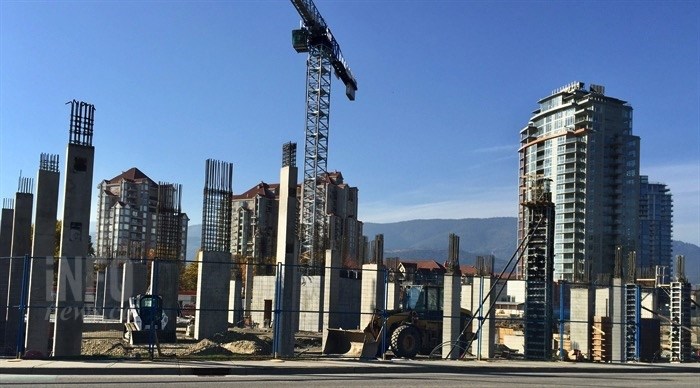
(ROB MUNRO / iNFOnews.ca)
February 18, 2022 - 7:00 AM
Back in 1986, Kelowna had almost caught up to Kamloops in terms of population. Both had around 61,000 people but Kamloops had about 500 more. That was the last census where Kelowna was actually smaller than Kamloops.
Since then, Kelowna has grown by 136% to 144,576 people, more than twice Kamloops’s 58% growth rate that took it to 97,902 in 2021, according to data from the 2021 census released last week.
A similar, but less extreme, flip happened between the third and fourth largest cities in the Thompson-Okanagan.
Back in 1986, Penticton ranked third in size with 23,588 residents while Vernon – which was the first incorporated city in the Okanagan, in 1892 – had fallen behind at 20,241.
Since then, Vernon has grown by 120% to 44,519 while Penticton’s growth rate was similar to Kamloops at 56%, meaning it only had 36,885 residents on the May 11, 2021 census date.
Kelowna had a growth rate of a whopping 13.5% during the period between the 2016 census and this year's count versus 8.4% for Kamloops.
Kelowna city staff, based on Province of B.C. growth forecasts, had projected growth by 40,000 to 45,000 new residents in the next 20 years.
If the city continues to grow at 13.5% during each census period, it’s more likely to hit 240,000 for the 2041 census period, or 95,000 more.
“We’re keeping a close eye on it and we’ll adjust as needed,” James Moore, Kelowna’s long range policy planning manager, told iNFOnews.ca.
In the last census, the province’s population estimates were within a few hundred of what showed up at census time in 2016.
Those estimates are way off this time, about 11,000 short of the actual number.
“I don’t think anybody would have predicted we were going to get the kind of seismic shift in population that we’ve seen in the past couple of years, particularly during the pandemic,” Moore said. “The question before us now is about whether this is a blip on the radar or whether this is a sign of things to come? Is this the new normal or is this something that happened during the pandemic and will wane following it?
With a new community plan in place, it gives city staff the guidance to accommodate another 45,000 people and there are built-in revisits every five years, just in case the growth rate is way faster (or slower) than projected.
“We can adjust our long-term growth plans but there are impacts from short term spikes like we’ve seen,” Moore said. “Those are things we can’t correct immediately. We can’t make housing more affordable immediately.”
It’s up to the private sector, for the most part, to read the market and build homes for the growing population. But that takes time.
On the quick side, the city has a relatively new RU7 zone where four-plexes can be built on single-family lots without being tied up in bureaucracy. That means four new homes can be occupied in about a year. But big multi-family projects, such as highrises, can take three or four years to complete.
“Housing supply is not the most elastic thing,” Moore said. “It takes time to respond to the demand. It takes investors to see the need, find the finance to back it, builders to build it and that takes time. And, in the meantime, you can have a significant spike, like we have, over two or three years.”
That means the current Kelowna building boom is not keeping up with demand even though there’s lots of new housing on the way.
Construction of the first two towers at Water Street by the Park, including one at 42 storeys that will become the tallest in Kelowna, is expected to break ground before the end of the month. They will provide 496 homes but won’t be complete for a couple of years.
There are another dozen highrises proposed or under construction in the St. Paul/Bertram Street area, including three towers that will include the UBC Okanagan downtown campus.
READ MORE: 2 highrise towers to be 'jewel-like centrepiece' of UBCO’s downtown Kelowna campus
“Do we have a lot in the pipeline?” Moore said. “For sure, there’s a lot of development in the pipeline to try and respond to that over the next couple of years. If the industry perceives there to be continued demand at that pace then, I think, we’ll see continued response in new development at that pace. But there’s a bit of lag before units can hit the ground to meet market demand.”
READ MORE: Kelowna’s record year for building permits rivals Surrey
In the meantime, housing prices and rents continue to climb dramatically in Kelowna, making it one of the most expensive cities in Canada to live.
There is also be the question of finding enough workers to build all the houses – along with the shops and industrial plants – that such dramatic growth demands.
Already there is a labour shortage of 21,000 unfilled jobs in the Thompson-Okanagan region.
READ MORE: More than 21,000 jobs unfilled in Thompson-Okanagan
To contact a reporter for this story, email Rob Munro or call 250-808-0143 or email the editor. You can also submit photos, videos or news tips to the newsroom and be entered to win a monthly prize draw.
We welcome your comments and opinions on our stories but play nice. We won't censor or delete comments unless they contain off-topic statements or links, unnecessary vulgarity, false facts, spam or obviously fake profiles. If you have any concerns about what you see in comments, email the editor in the link above.
News from © iNFOnews, 2022